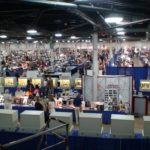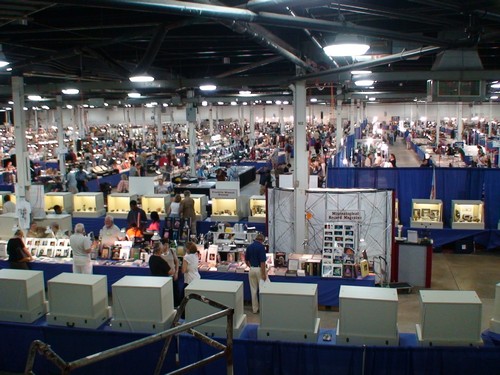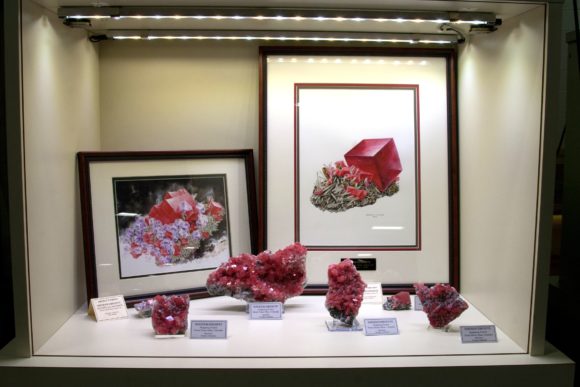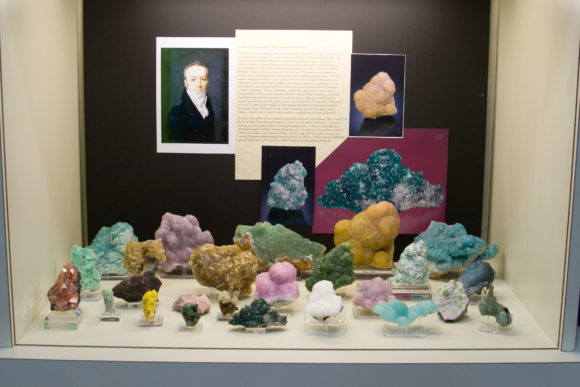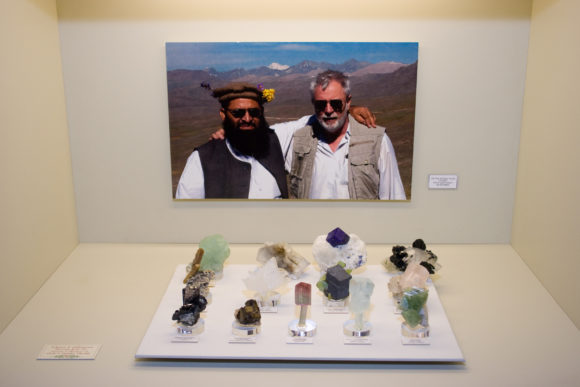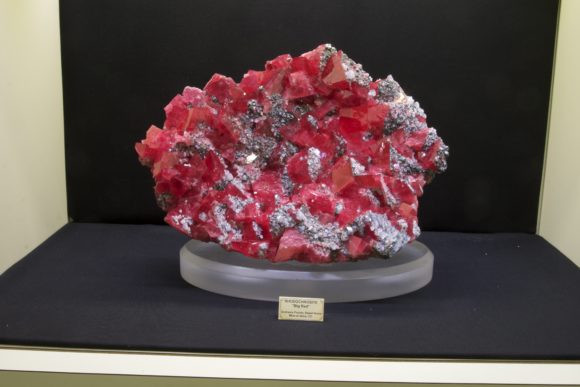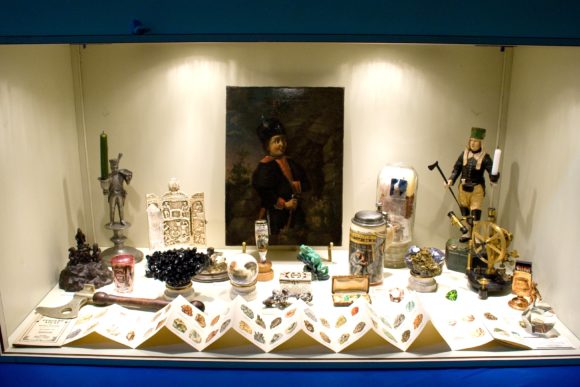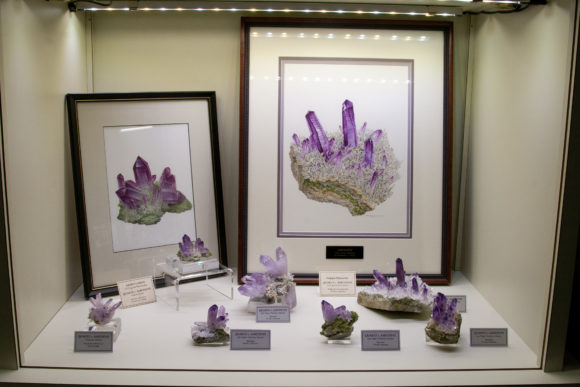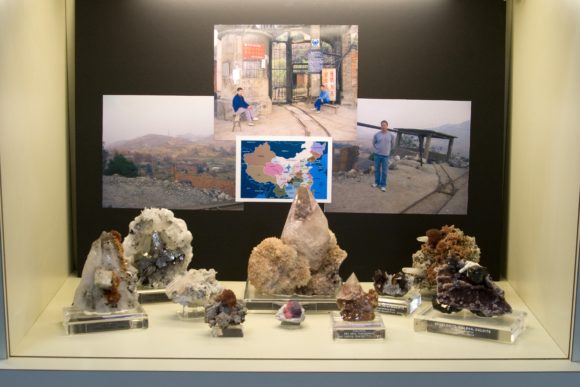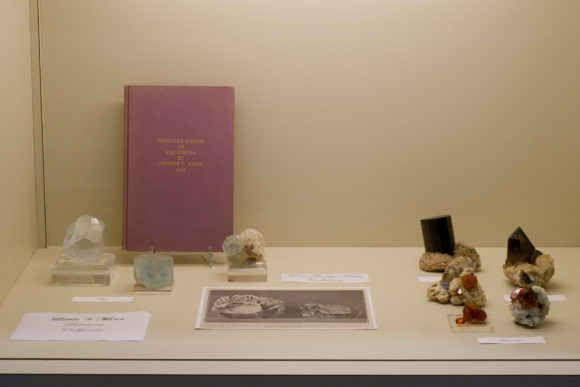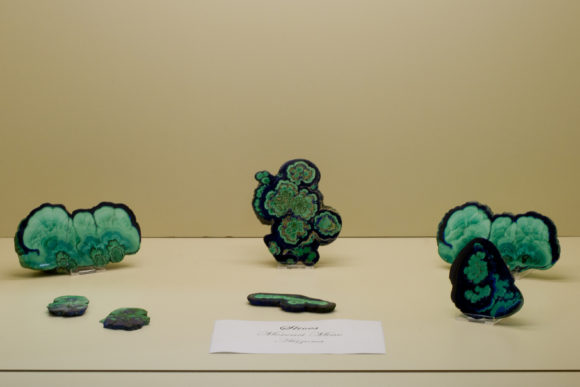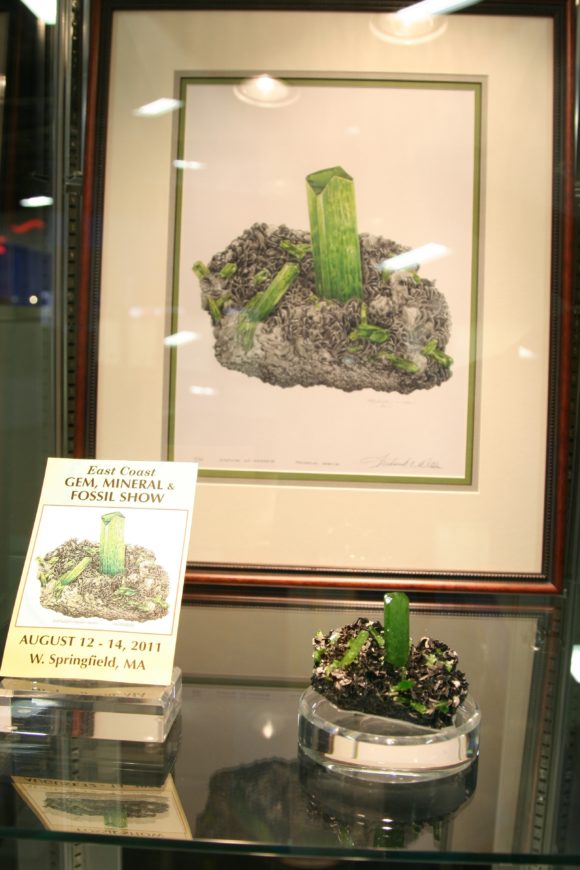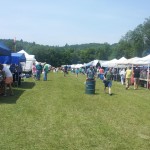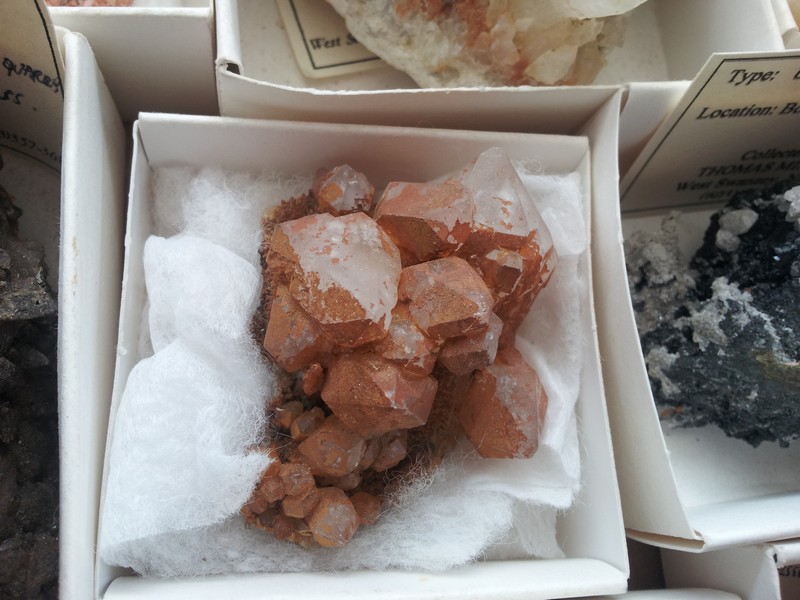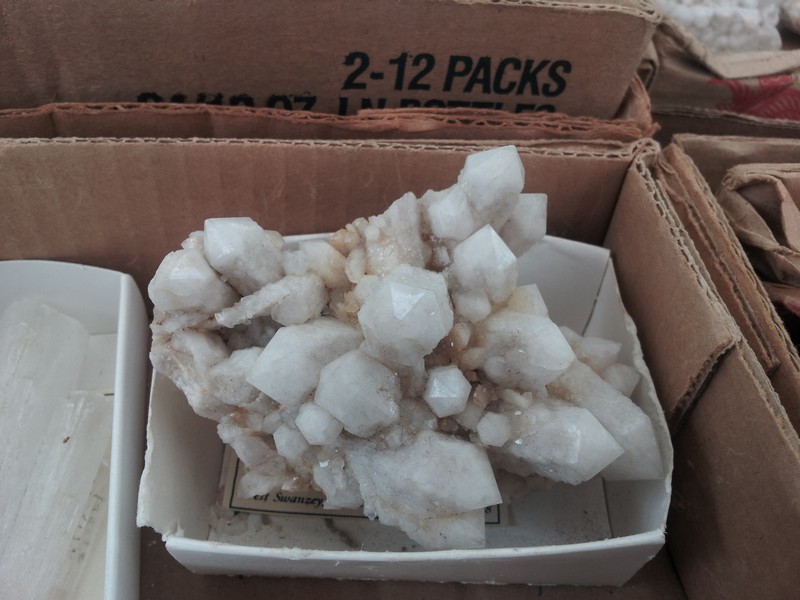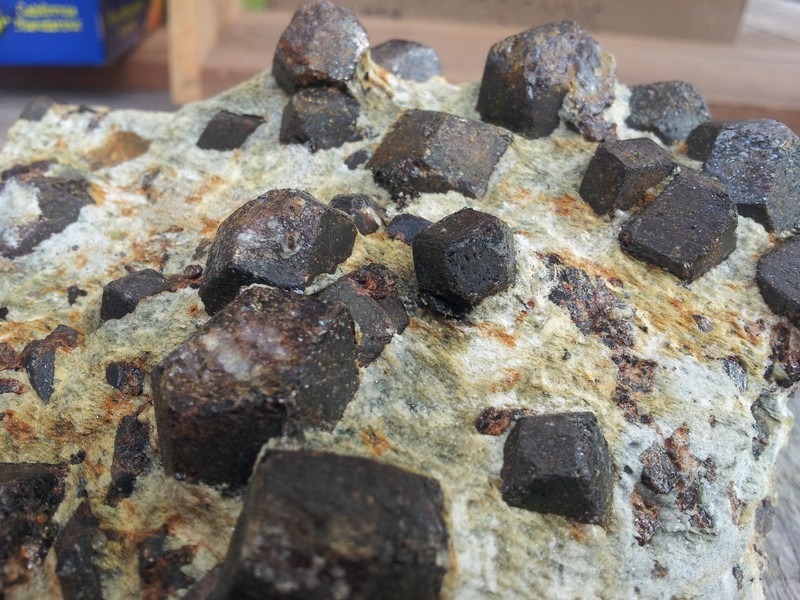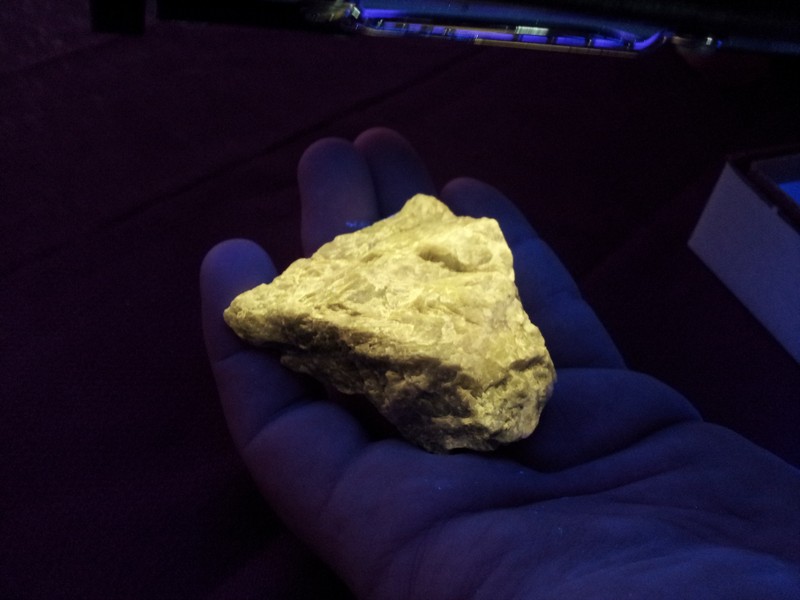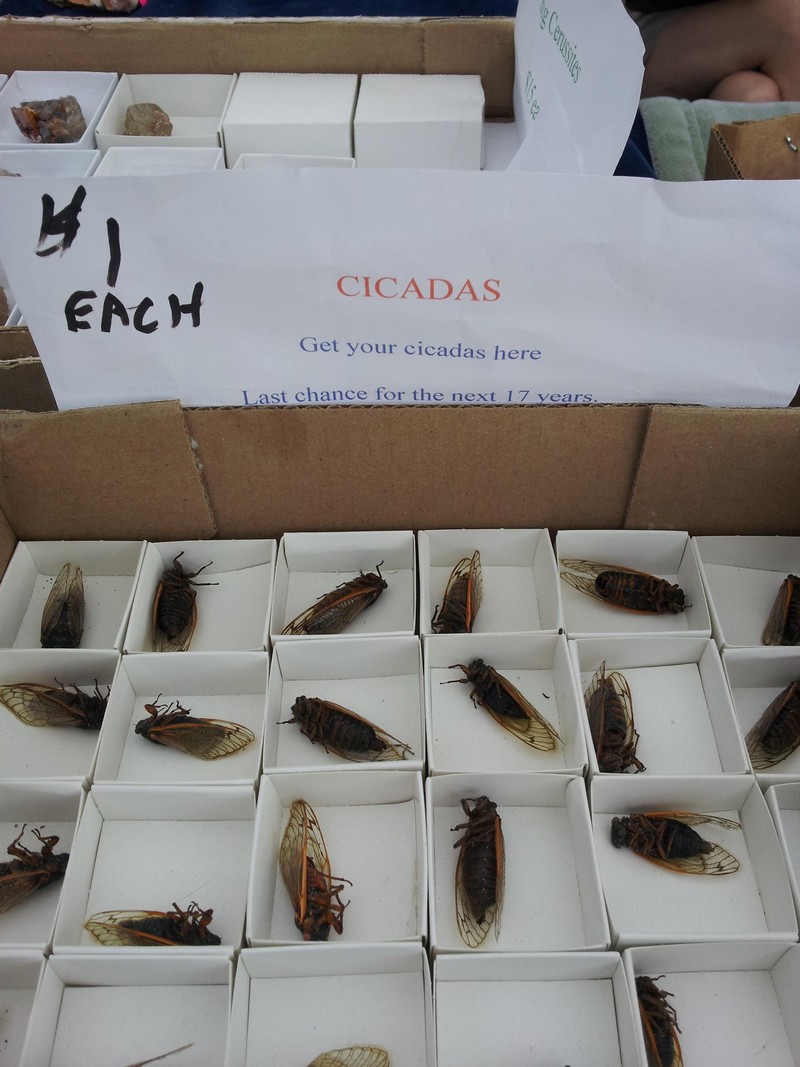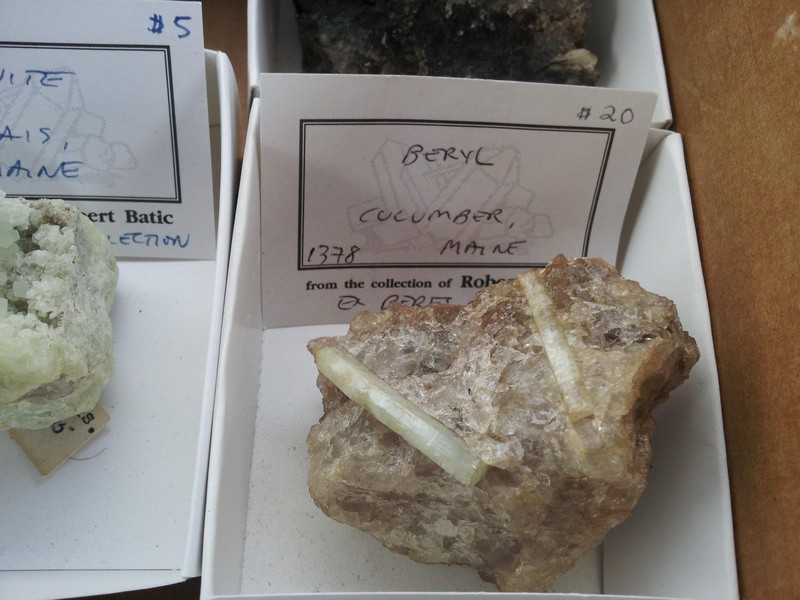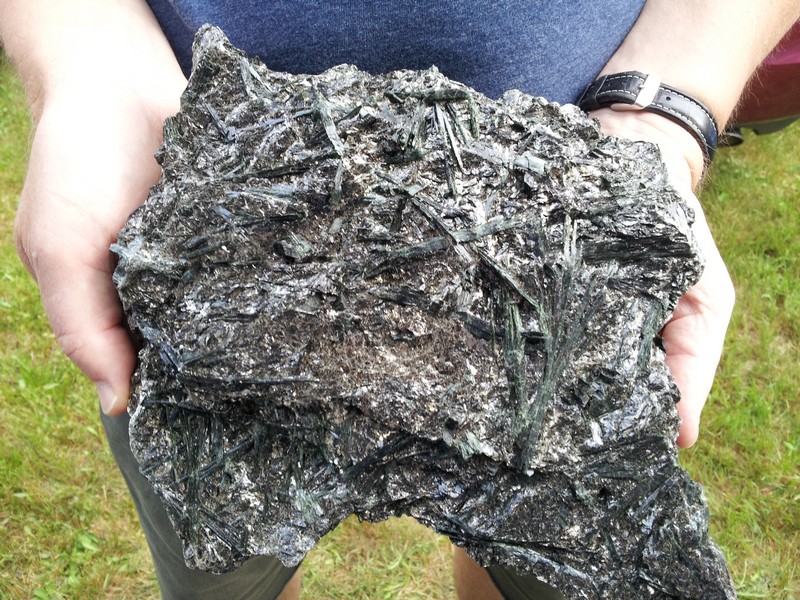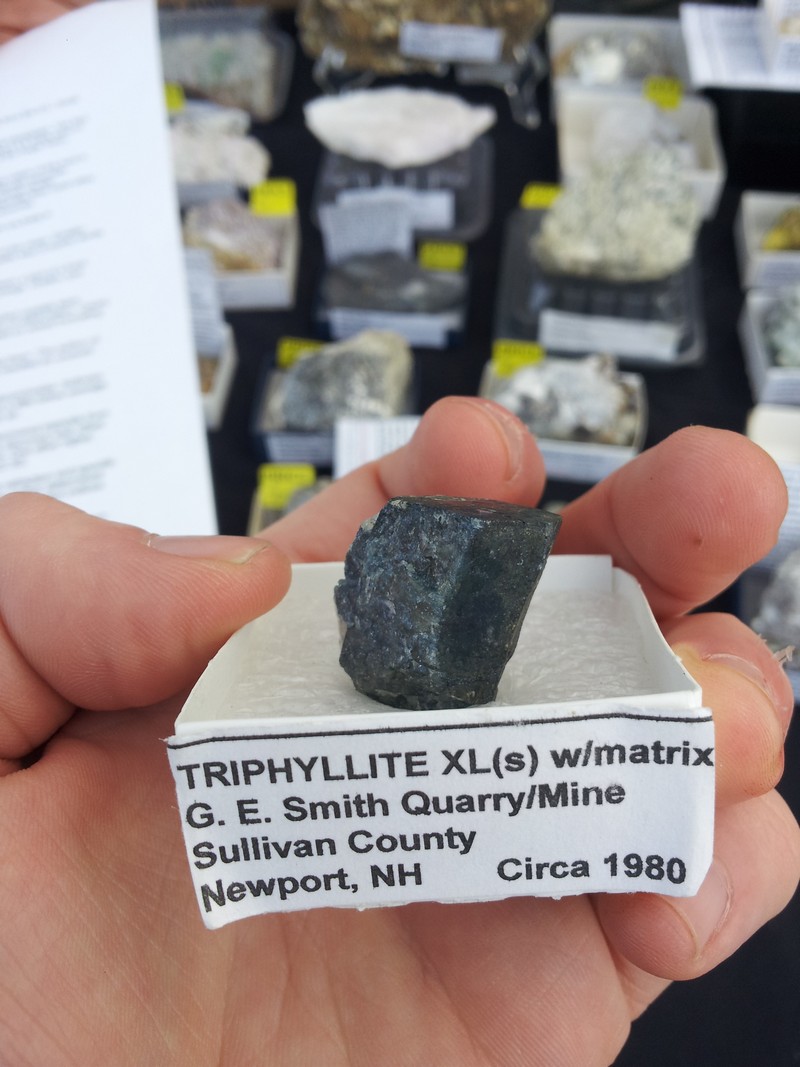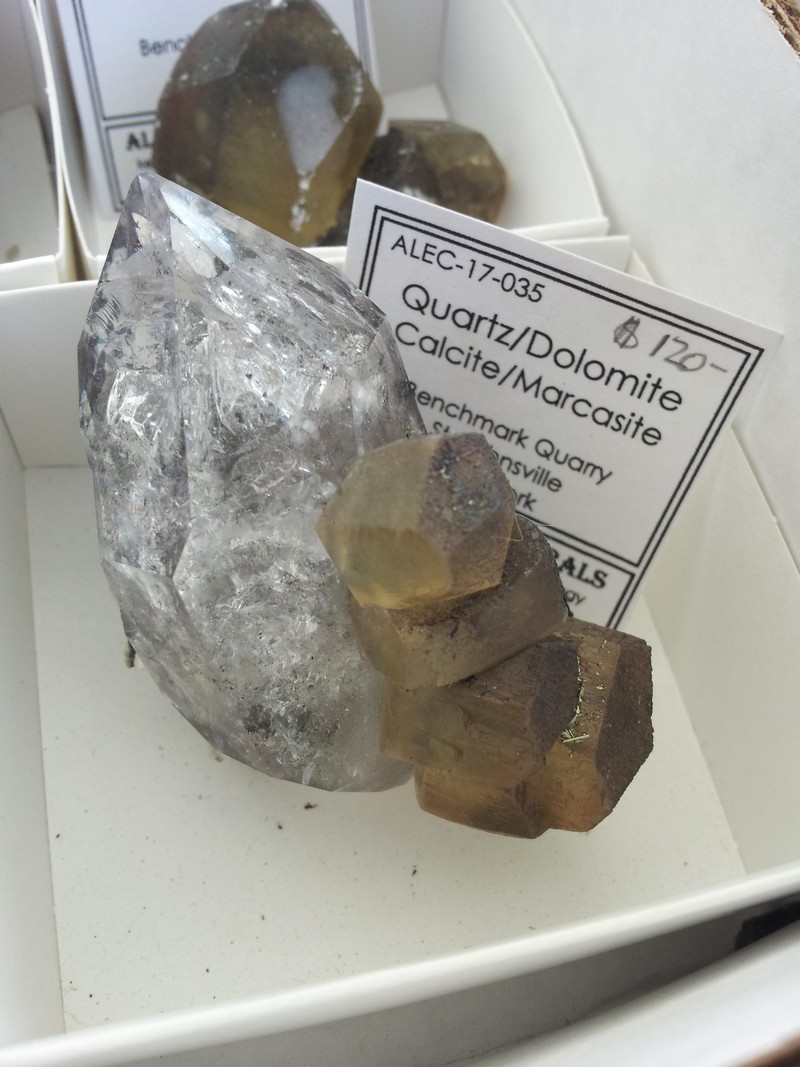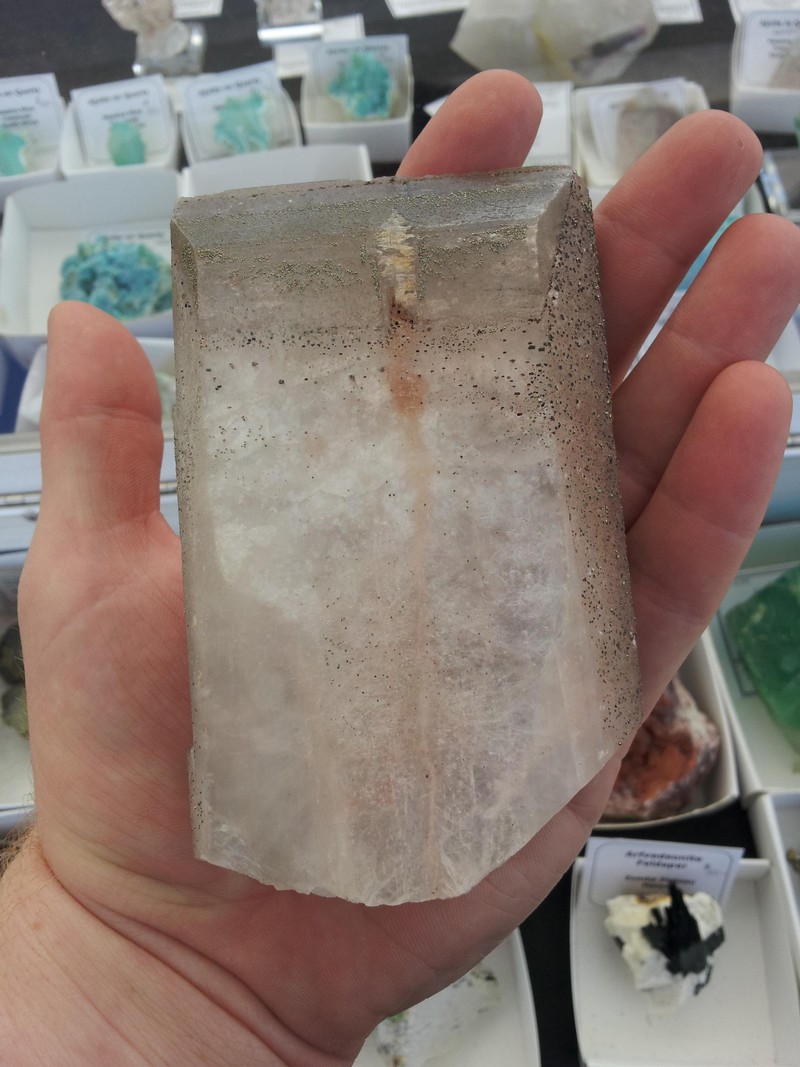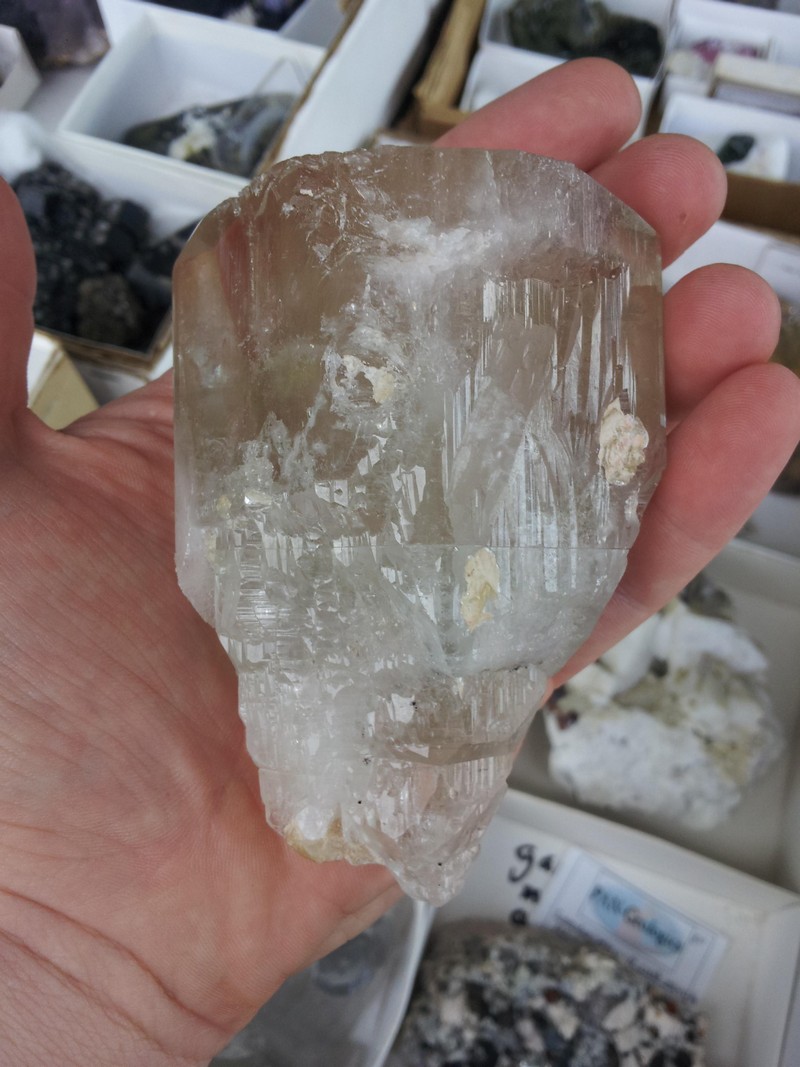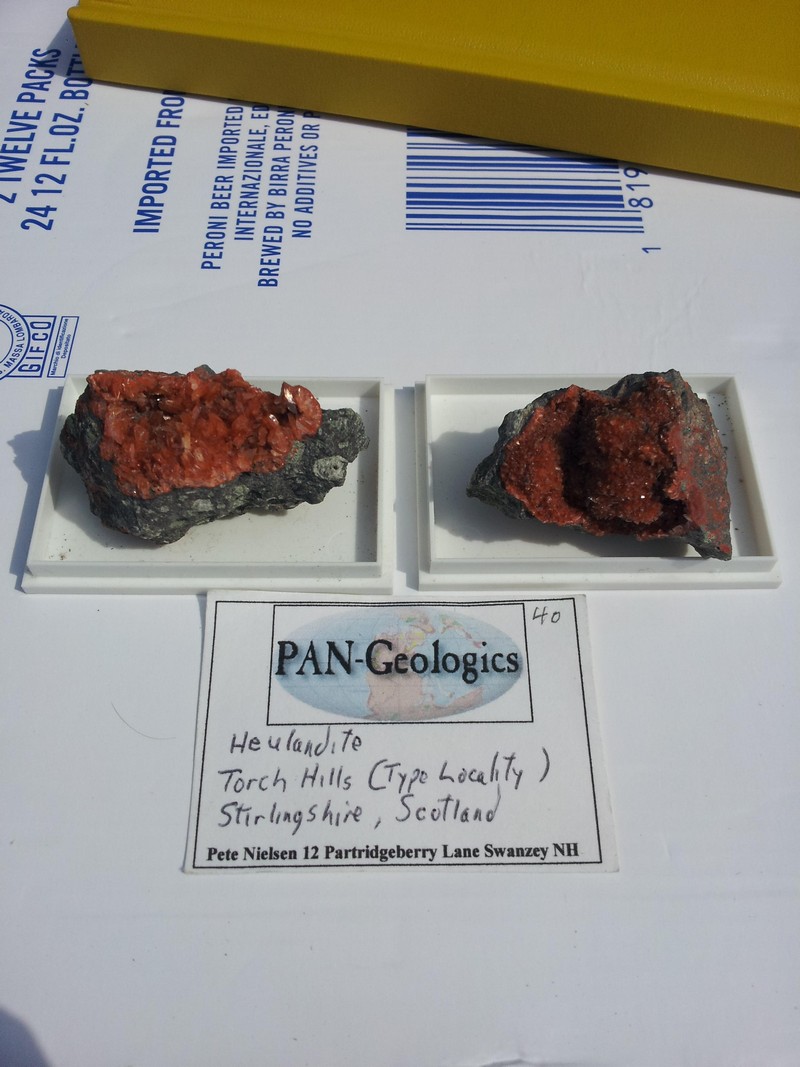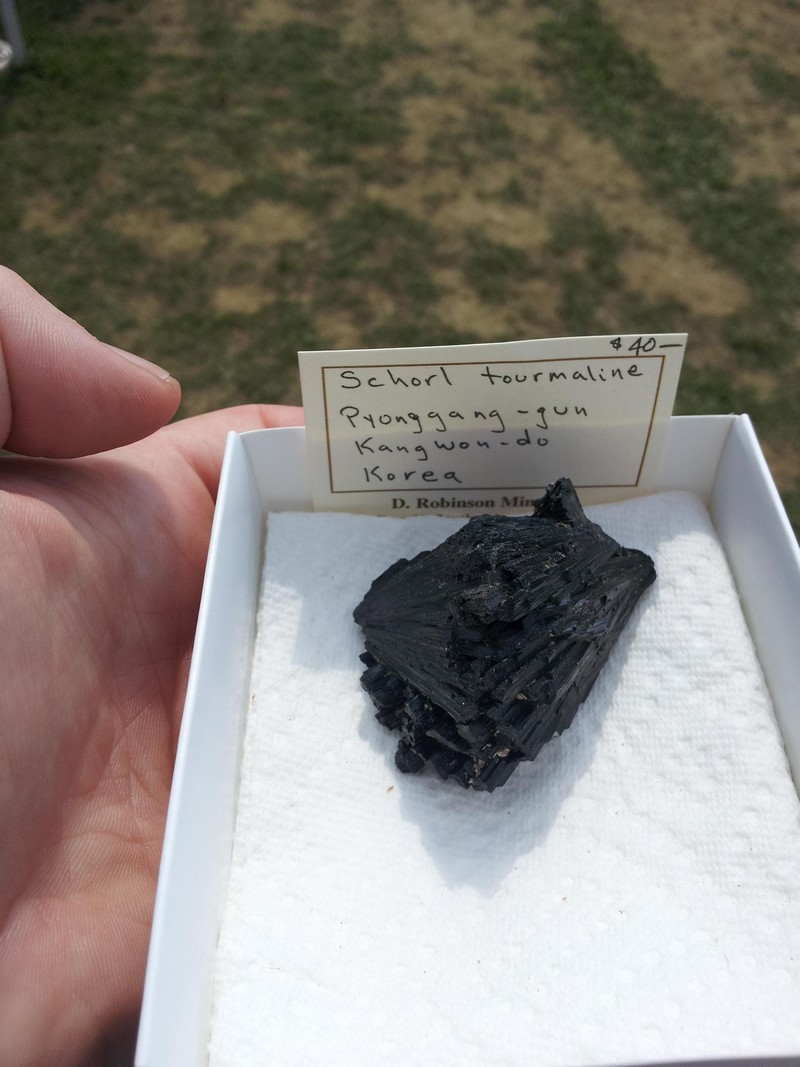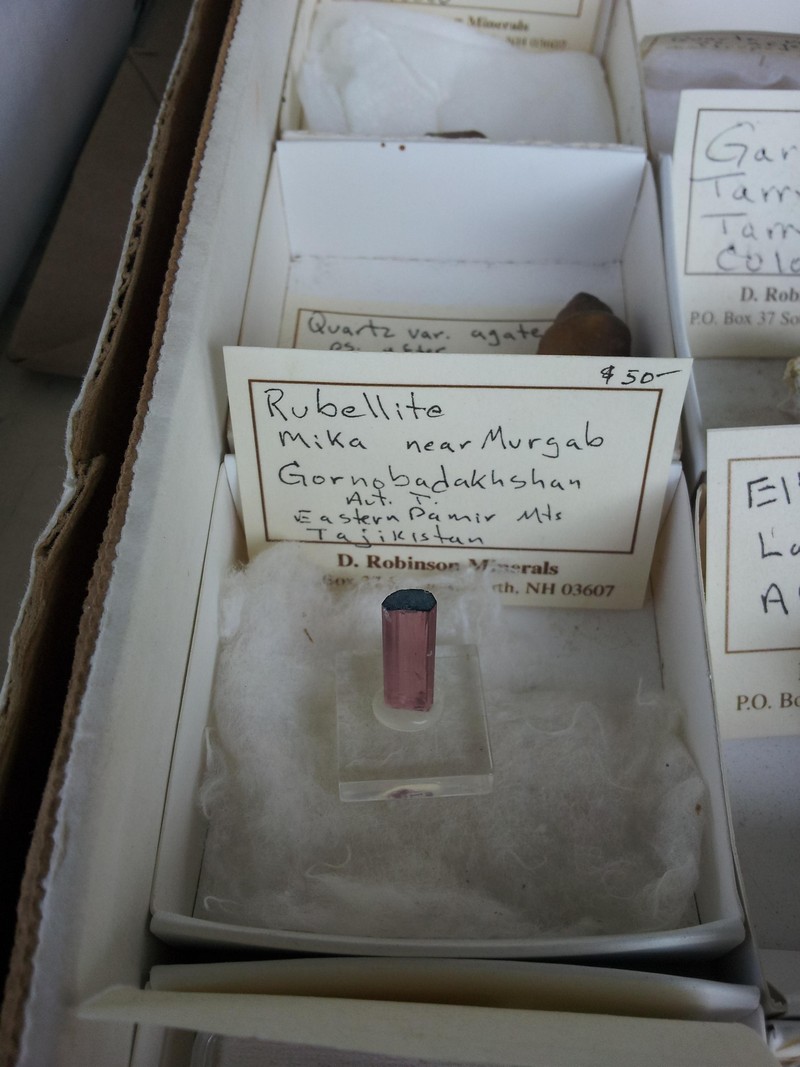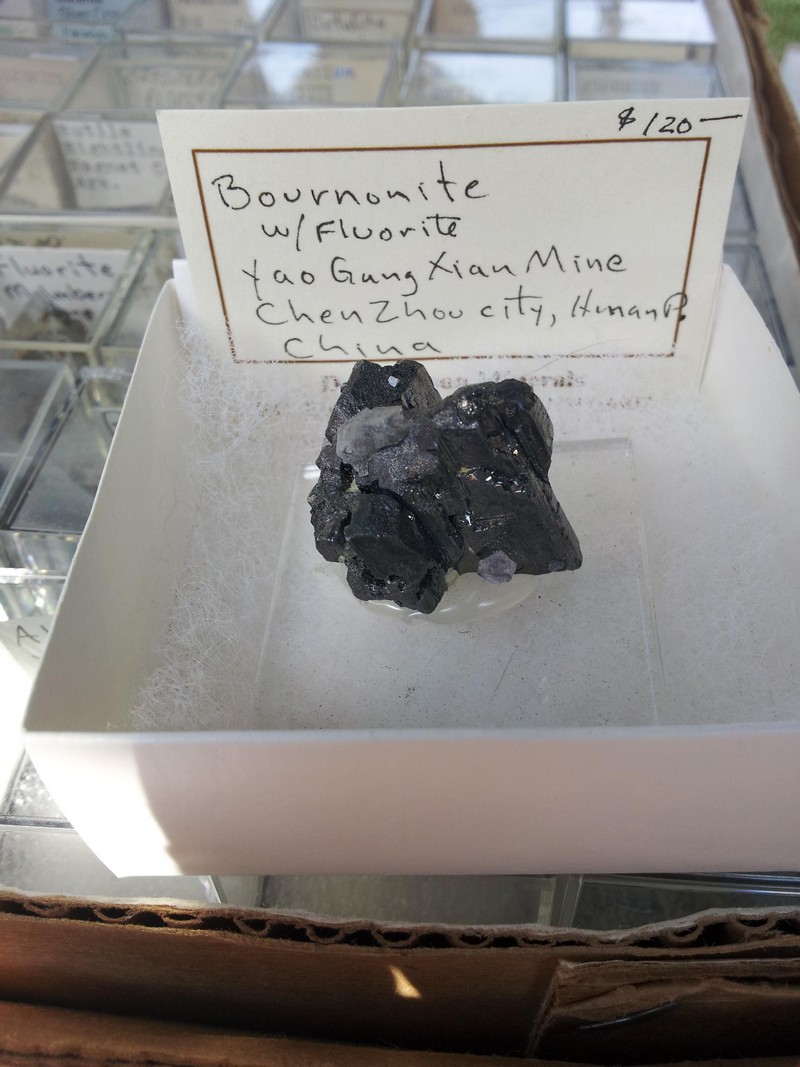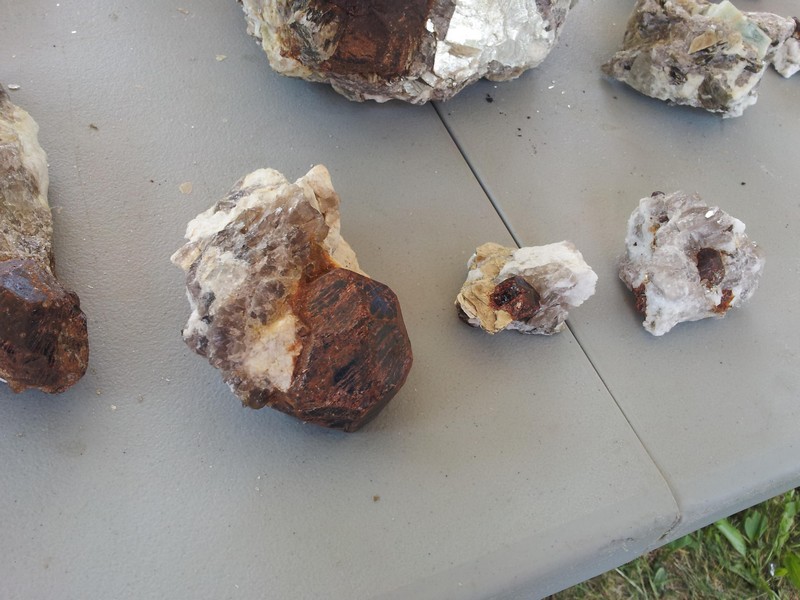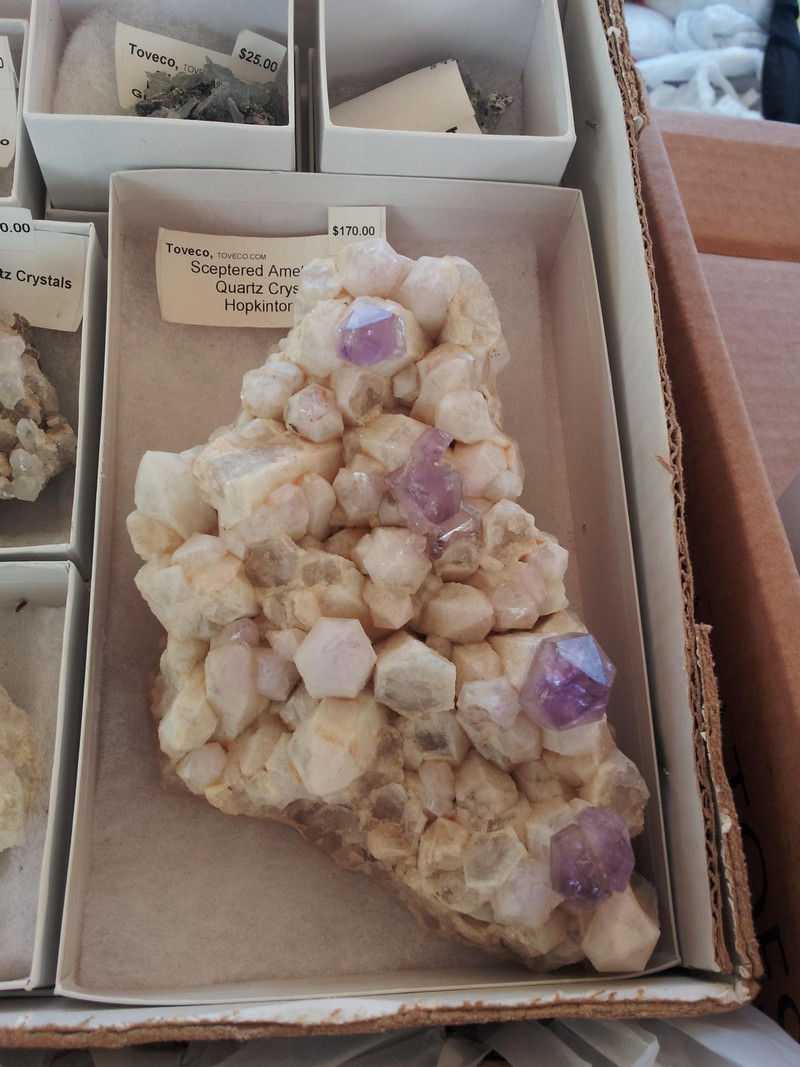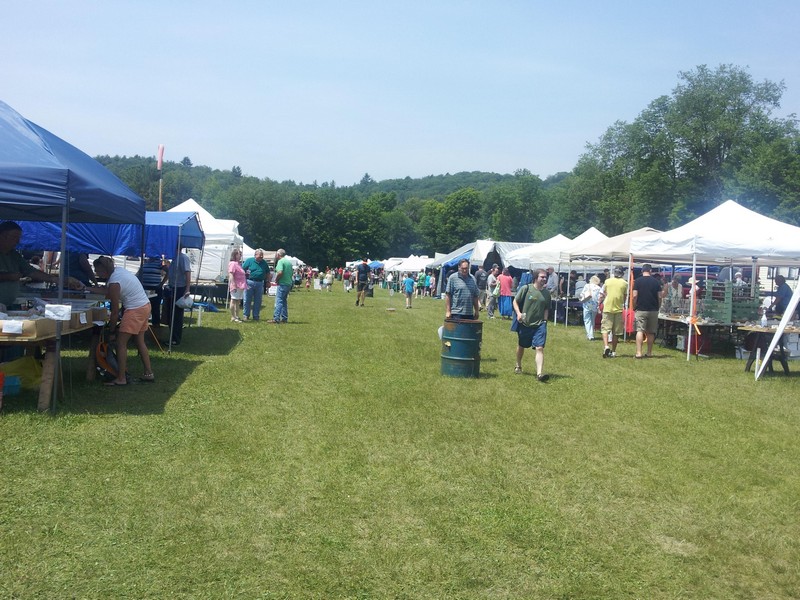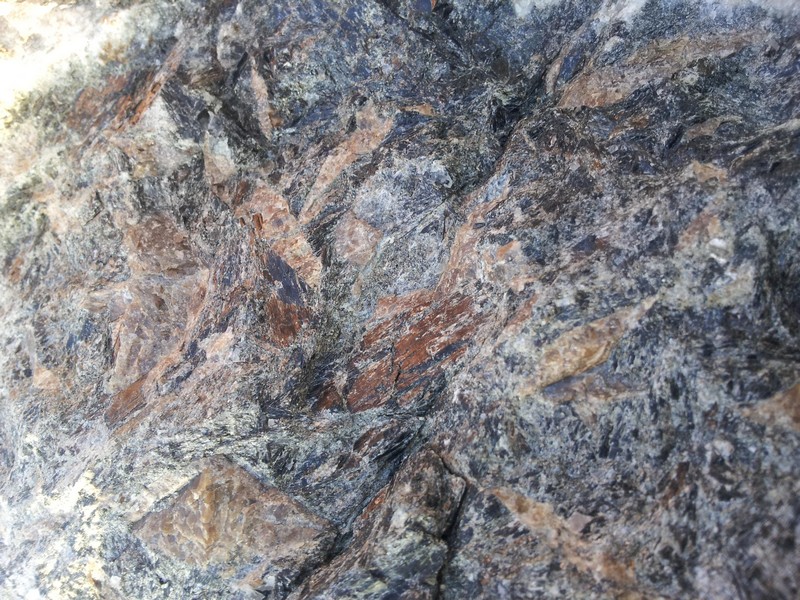
A Visit to the Castro Valley Mineral Club Show, 2014
By Jeremy Zolan – Earth Surgery
The Mineral and Gem Society of Castro Valley puts on an excellent small mineral show each year at the Newark Pavillion in Newark, CA. This small locally focused show great for all audiences and ages, and makes for a wonderful weekend outing especially with family and friends! This show attracts dealers who offer an extremely wide array of material ranging from gem and lapidary rough to rare minerals. There are also many displays and booths offering activities, information, and many other things in addition to those who strictly sell specimens. During my visit, everyone at this show was extremely kind and made me feel welcome to the California collecting scene which I am extremely new to. For new residents of California looking to make connections, this is a great springboard into the scene.
I have recently been staying in the the Barstow area of Southern California so getting to this show was quite a drive. It did allow me a first glimpse at the landscape of many interesting places I have never visited before and was very scenic. Here we have a picture of high desert scrub in Boron, CA with the titanic US Borax Mine lurking barely visibly in the distance. Many of the hills in the photo are partially made from giant tailings piles. This mine is not only famous for its incredible size and high production but for its mineralogy which is highly distinctive. In addition to producing many thousands of fine colemanite specimens, it also is well known for splendid examples of many rare borates such as inyoite, kurnakovite, probertite, and kernite.
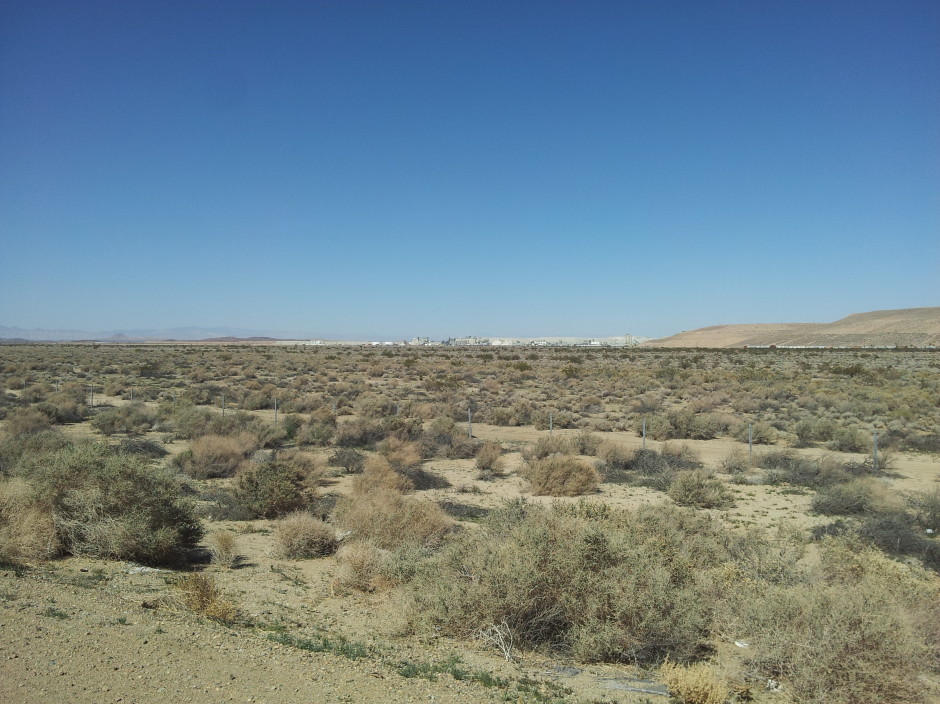
Scrub Desert on the way to a gem show in california
The first thing I did when I arrived at the show was check out the display cases, which there were many of for a small local event. In my home New England region, events of similar size only rarely have as many displays so I was pretty surprised. The cases were filled by a local crowd including both collectors and museums but definitely far more of the former rather than the latter. Lapidary, mineralogy, paleontology, and anthropological themes were all present in the displays however there was a significant bias towards the lapidary side of things with comparatively very few mineral display cases. This was somewhat reflected in the abundance of lapidary dealers at the show though there were also many great mineral and fossil dealers as well.
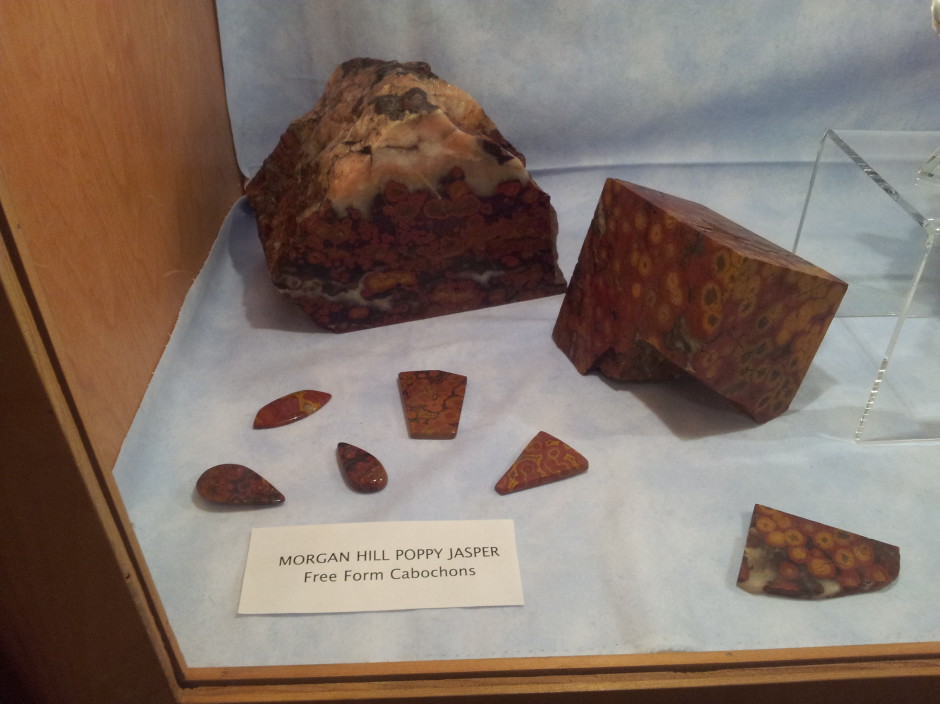
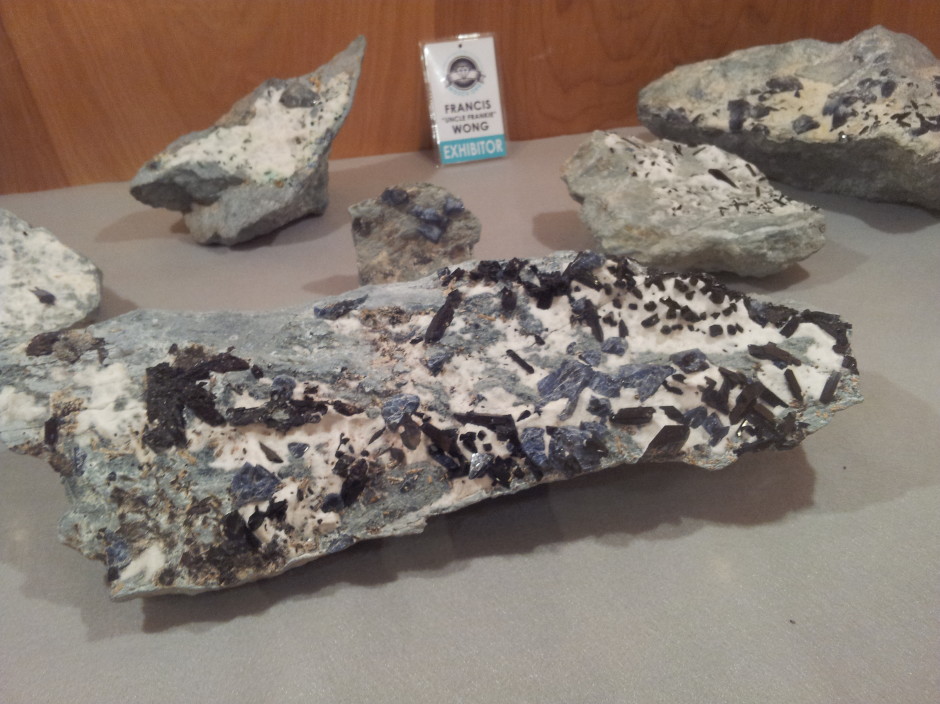
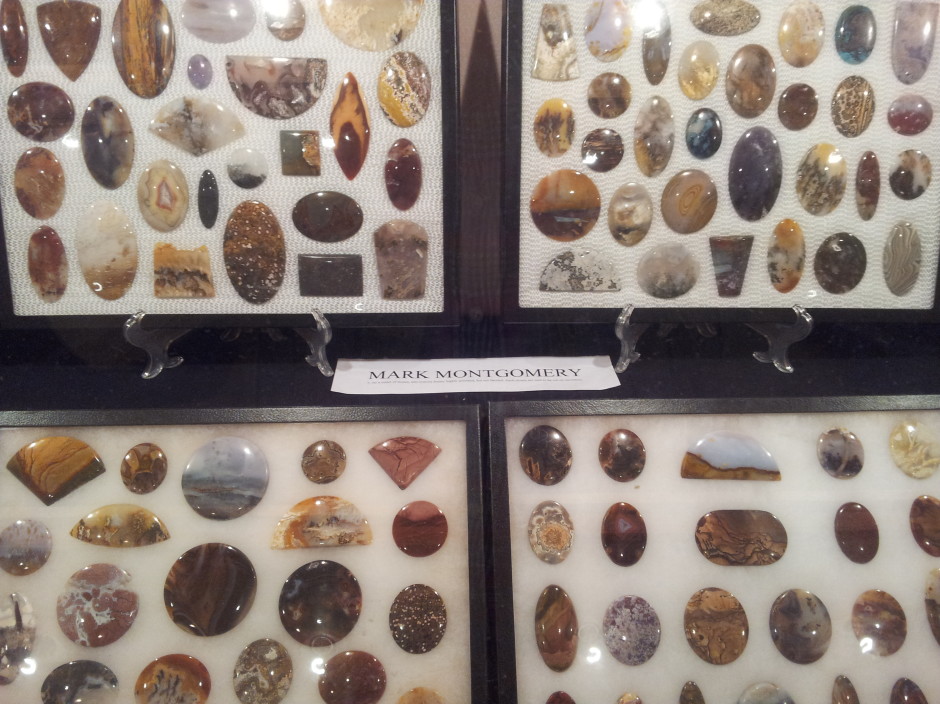
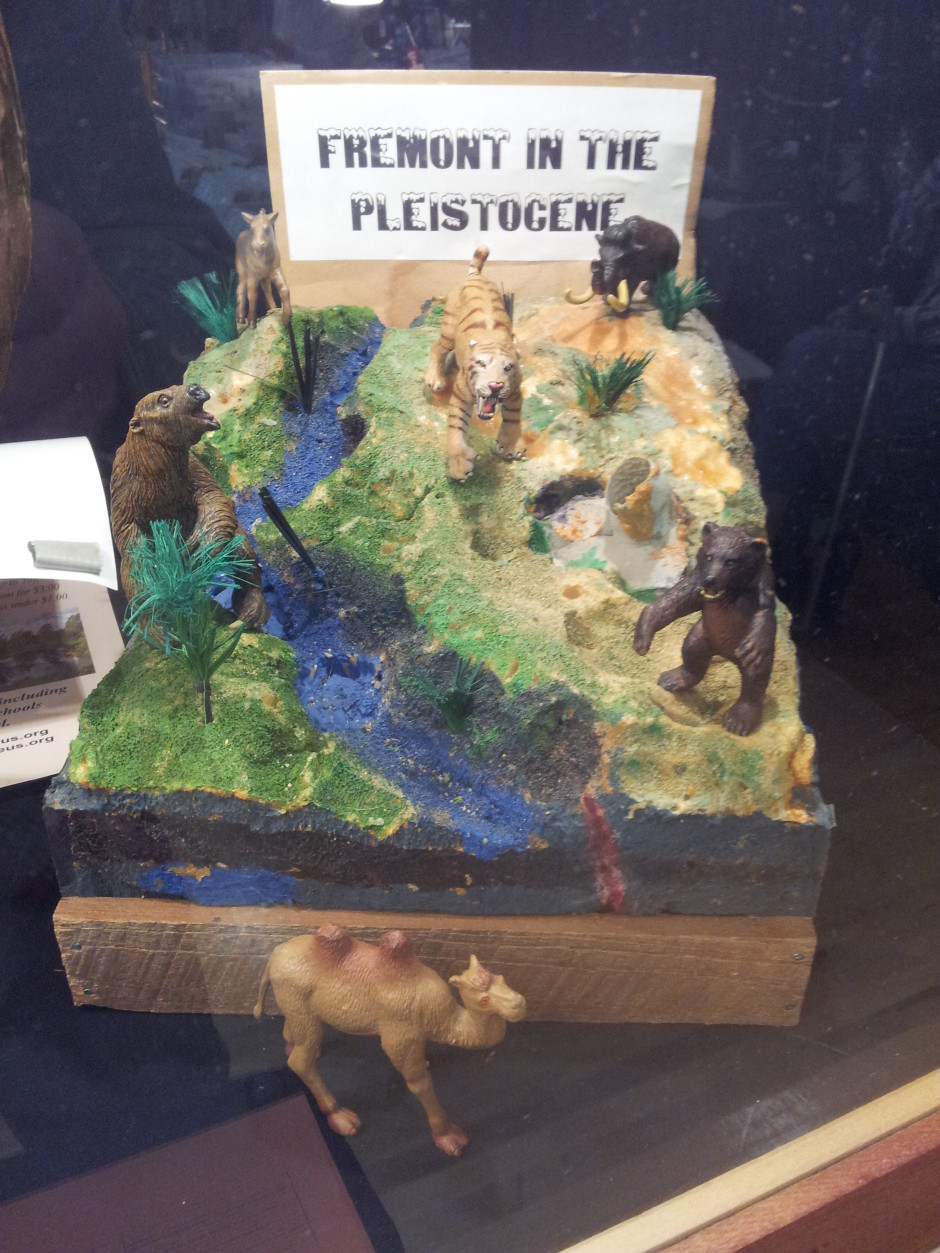
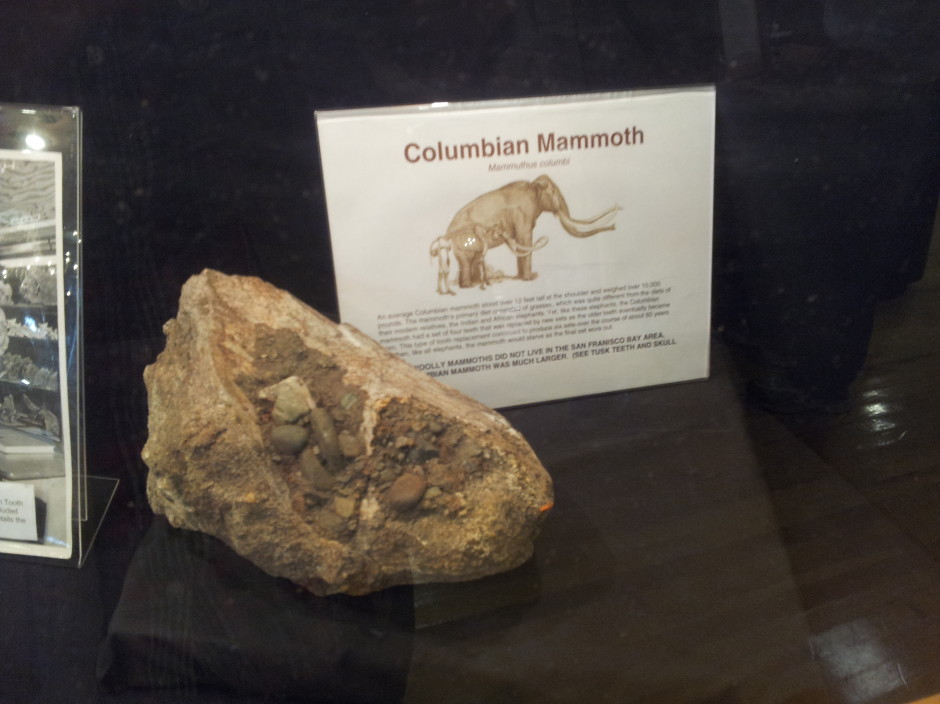
Next off, I decided to parouse the dealer booths and was pleased with the great variety in not only species and localities but prices I saw. There were many great specimens to be had for under fifty dollars including many lots of old material at multiple dealers that appeared to have not been repriced in decades. There was truly something for everyone at this event.
The first dealer I visited was The Uncarved Block which always has a good assortment of material though tends to mostly focus on classic, well known species that display best in the thumbnail to cabinet range. Many specimens stuck out to me but those pictured below were my favorite, most of which are things that rarely turn up on the West Coast.
First off we have two teal kyanite crystals in a biotite schist matrix from the Harts Range in the Northern Territory, Australia. The color indicates that the specimen may more precisely be from Huckitta Well or nearby. The crystals were aesthetically skewered through the matrix and had a very pleasing deep aqua blue color. The longest was exposed to about 6cm of its total length. The Harts Range is one of only a very small assortment of localities in Australia that produce gem pegmatite minerals such as beryl and garnets.
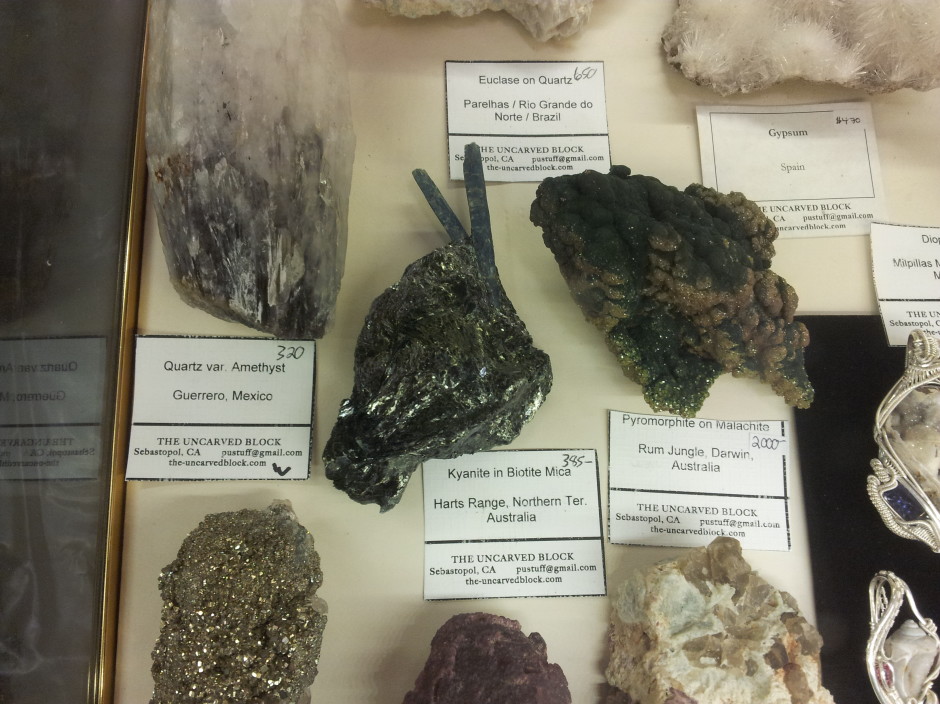
Next, I spotted this specimen of beryl from Slocum’s Quarry in East Hampton, Connecticut. This very uncommon, very old, and now very closed locality is well known for its yellow beryl var. heliodor crystals which were opaque to extremely gemmy and sometimes formed in pockets. The pocket crystals were often etched in a manner similar to the Ukranian crystals from Volodarsk-Volinskiithough their color saturation ranges to an extremely deep and gorgeous pumpkin orange color. Slocum’s Quarry also exhibits an impressive suite of rare Be, Nb/Ta, and REE minerals. Ernie Schlicter collected the below piece which has bigger crystals than most by far even though they are of a very light color for Slocum’s.
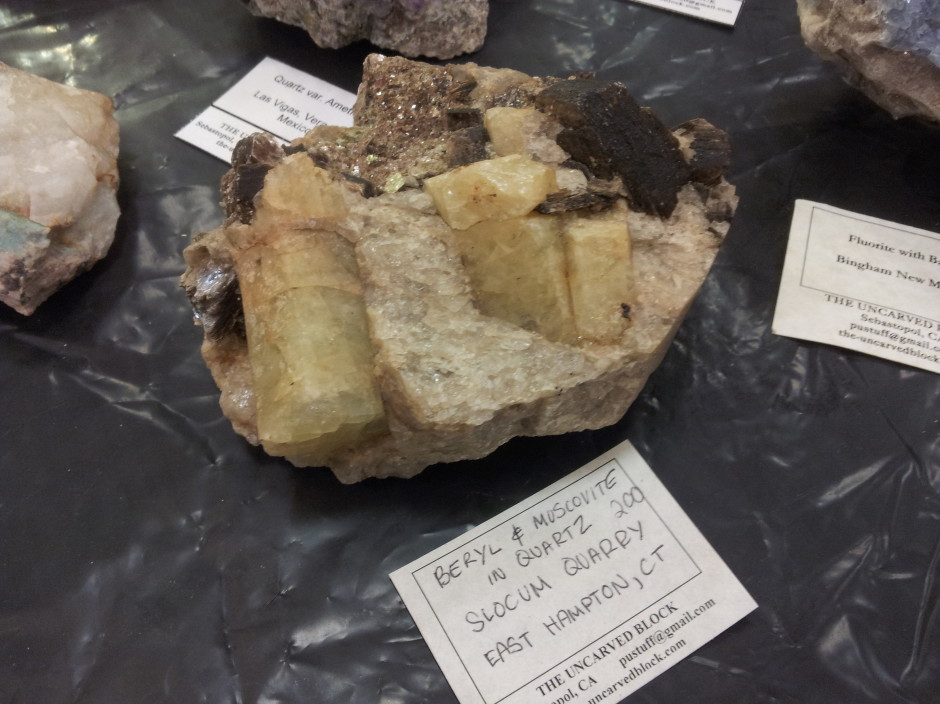
Romanian amethyst from Porkura, Huneodoara Co. is something I am always looking out for and in my opinion, are some of the world’s great amethysts with their extremely deep color saturation and unusual crystal shapes. They strongly resemble newer specimens from Guerrero, Mexico but being the snob that I am, I think the Romanian specimens always have better color. I really loved this piece which has the perfect balance of purple cityscape-like crystals and contrasting matrix. Truly a fine amethyst.
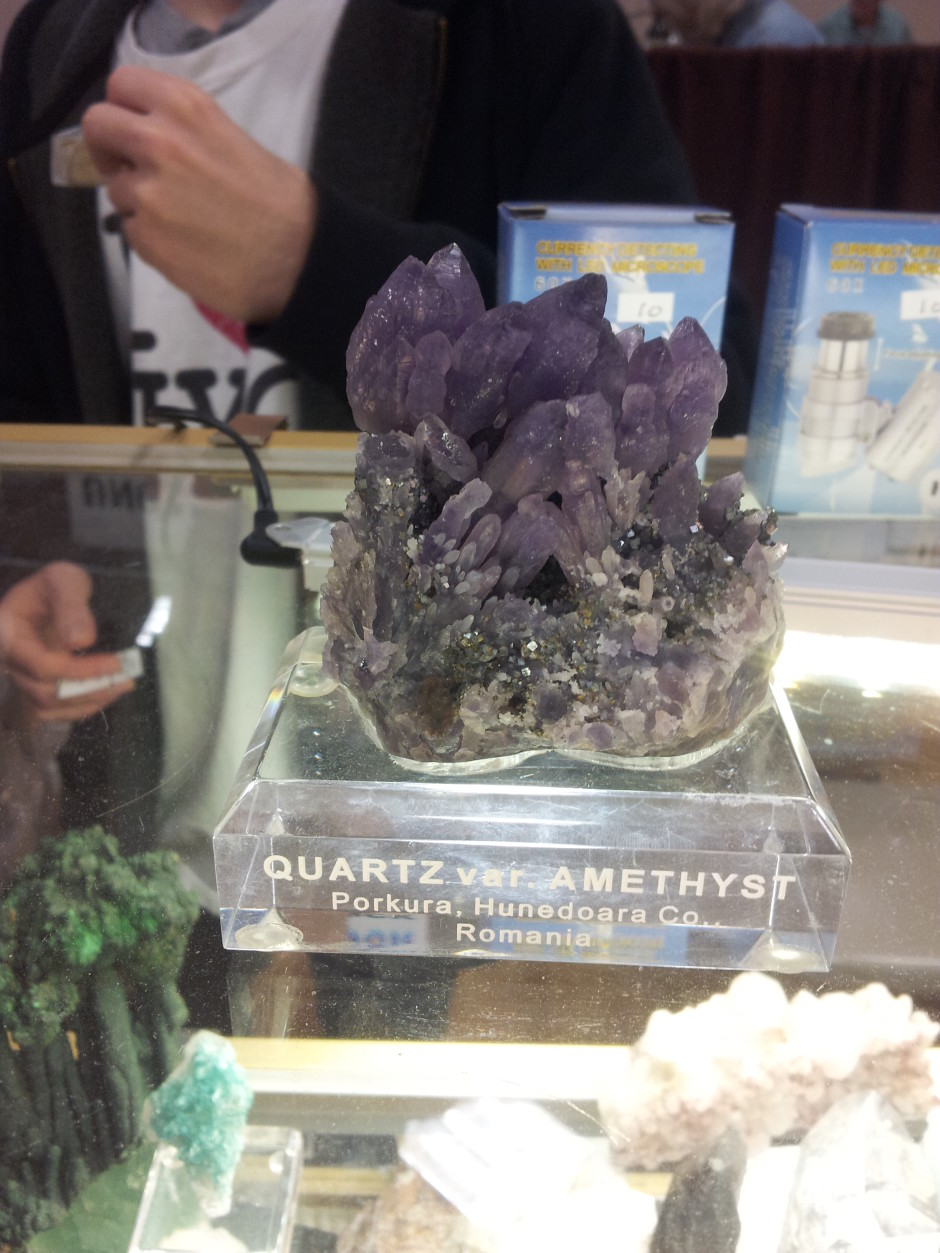
Finally, I spotted this set of alphabet agate from Indonesia. The letters are formed by natural tubular inclusions of iron oxides and clays in the agate. These sets always amaze me. Imagine how many thousands of pieces must be sorted through to get a full alphabet! Truly a daunting task, it has been said to take years to find a full set by inspecting rough. Some letters such as R and Q with unusual shapes are apparently rarer than others.
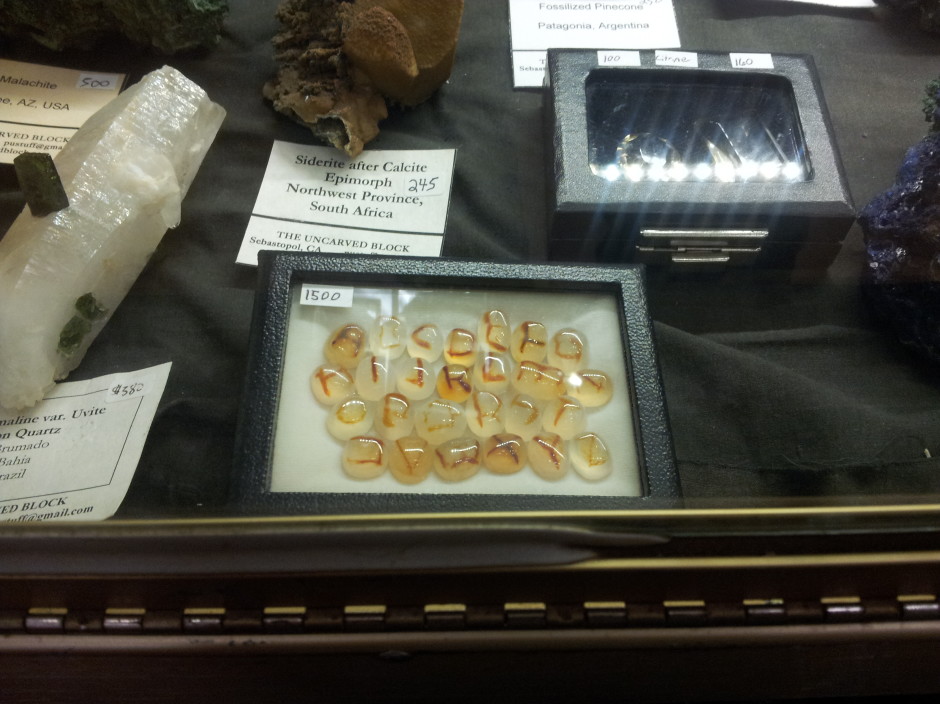
It was then over to Earth’s Treasures, run by avid field collector Rick Kennedy. Rick has been working the California Blue Mine in San Bernardino County for aquamarine, topaz, quartzes, wodginite, and other associated species. This locality is outside of what is traditionally regarded as the Southern California Pegmatite district so I had to know more considering it could change our perception of pegmatite mineralogy in California. It appears that this pegmatite is of intermediate elemental distribution (LCT/YNF) though it is likely very lithium poor unlike some geochemically similar envirtonments though the micas would need to be analyzed to truly validate that statement. Greisenization took place in the top of the peg and created a lot of topaz and fluorite mineralization while deeper in were the nice gemmy aquas. Some of the crystals show interesting tapering that reminds me of specimens from Brazil and Argentina. Below is my favorite crystal from the locality he had for sale at his booth.
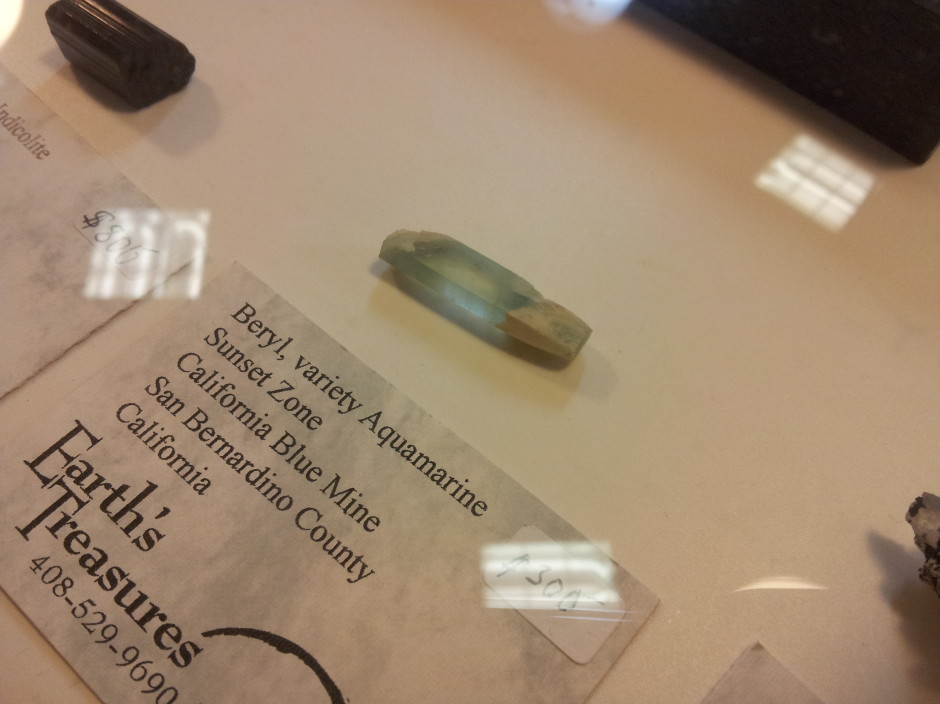
Rick had lots of other great material too; a lot of exotics especially. This limonite after magnetite pseudo is very peculiar especially. Considering Kansas is mostly sedimentary, one would not expect to see magnetite originating from there. Many of these magnetites were collected around 100 years ago.
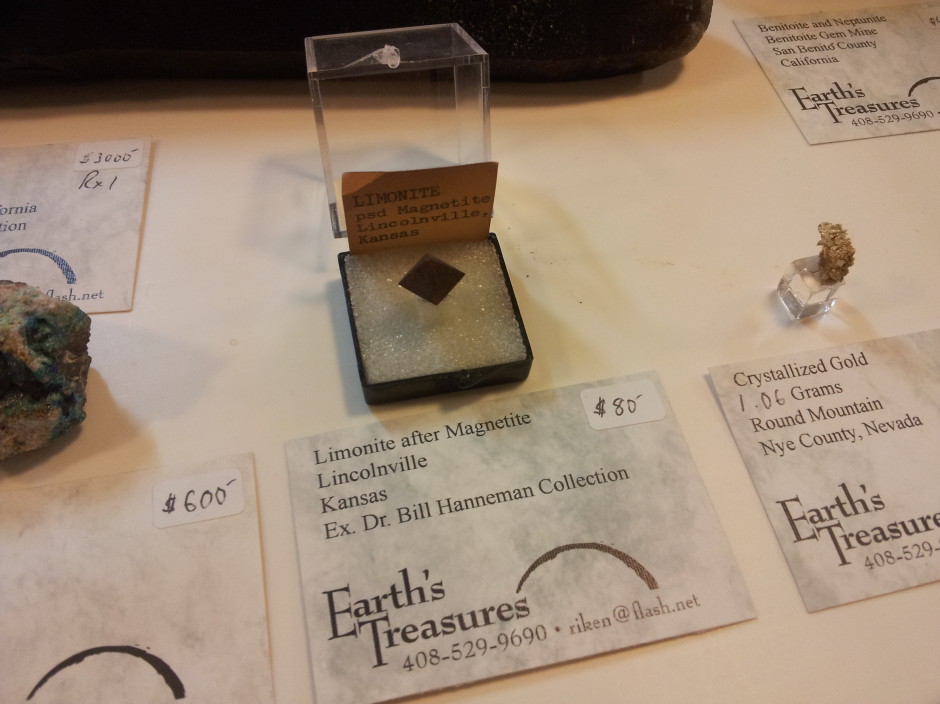
John Garsow had a lot of great material too with a focus on gem minerals, rough, and materials. John is also an avid field collector who has made some really nice finds in Southern California. He had this Chinese tourmaline that immediately caught my attention. If there is one group of minerals that China lacks it is pegmatite minerals. There are only two very poorly explored main areas for specimen producing gem lithium pegmatites in China; near Kashi, Xinjiang Uygur Province or the Gaoligongshan ranges in Yunnan Province. Both are located in notoriously remote and culturally distinct regions in western China. This piece, measuring in at around 8cm tall is from the latter which is known for mostly producing only tiny crystals to 2 or 3cm. Chinese specimens show frequent mislabeling so it is possible this is from another entirely different area since it does not resemble the majority of specimens I’ve seen from either Xinjiang or Yunnan Provinces. I thought it was a really fascinating piece for that reason.
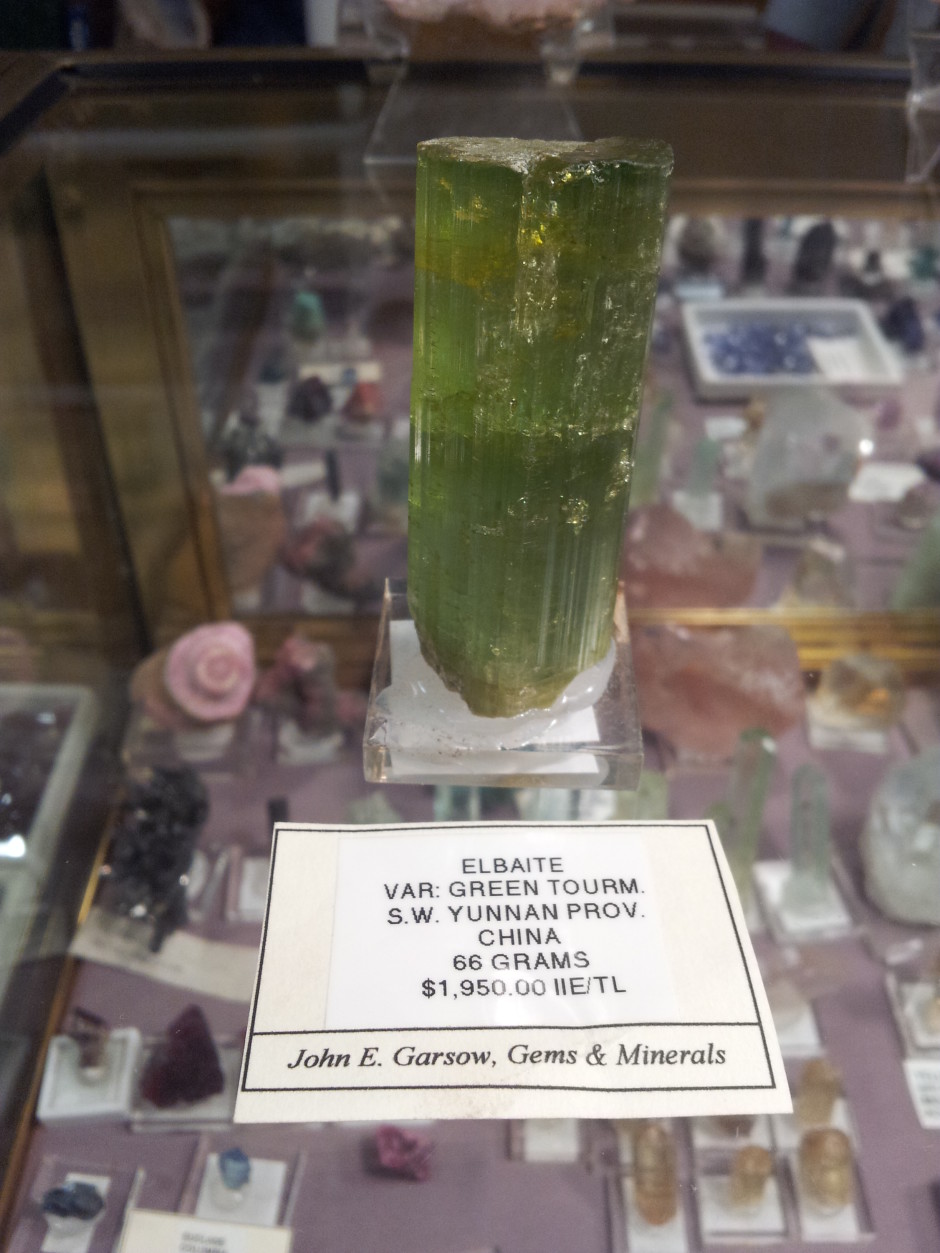
Taking a break from strictly minerals, I decided to check out the Northern California Geological Society’s booth to ask some questions about local geology since I am by no means well versed in the geology of California which is extremely different from those good old passive margins on the East Coast that I’ve explored and collected in so much. Mostly, I was curious about the formation, petrology, and mineralogy of blueschists and eclogites; rare, extremely high grade metamorphic rocks I was rewarded with kindness and a very thorough explanation. NCGS offers many excellent field trip publications exploring many themes in the northern California area. They also have an excellent scholarship program for B.S through Ph.D.-level students in California and the adjacent states.
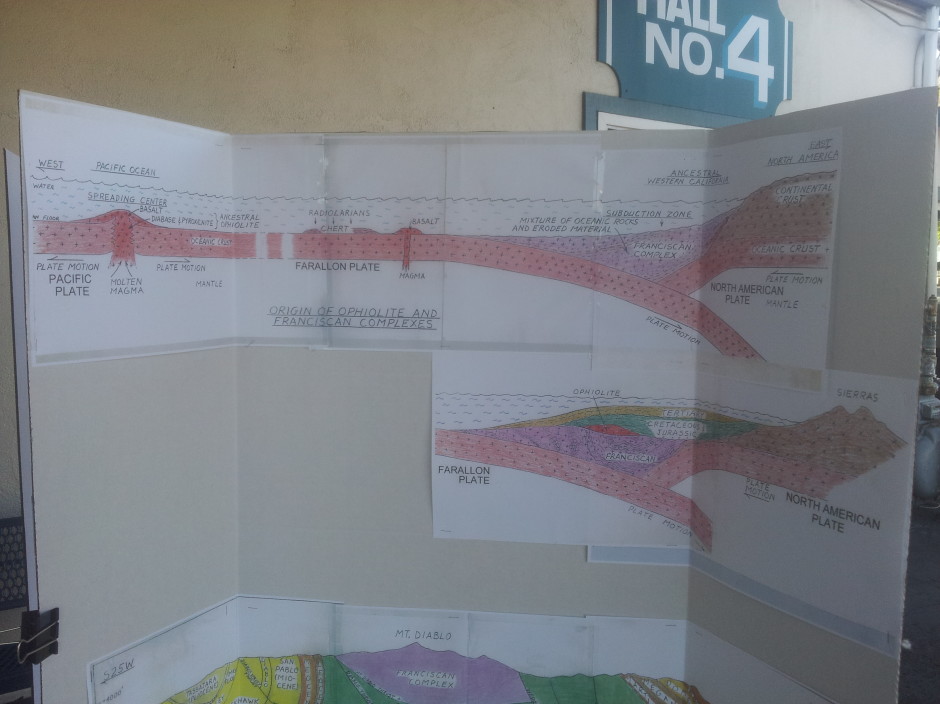
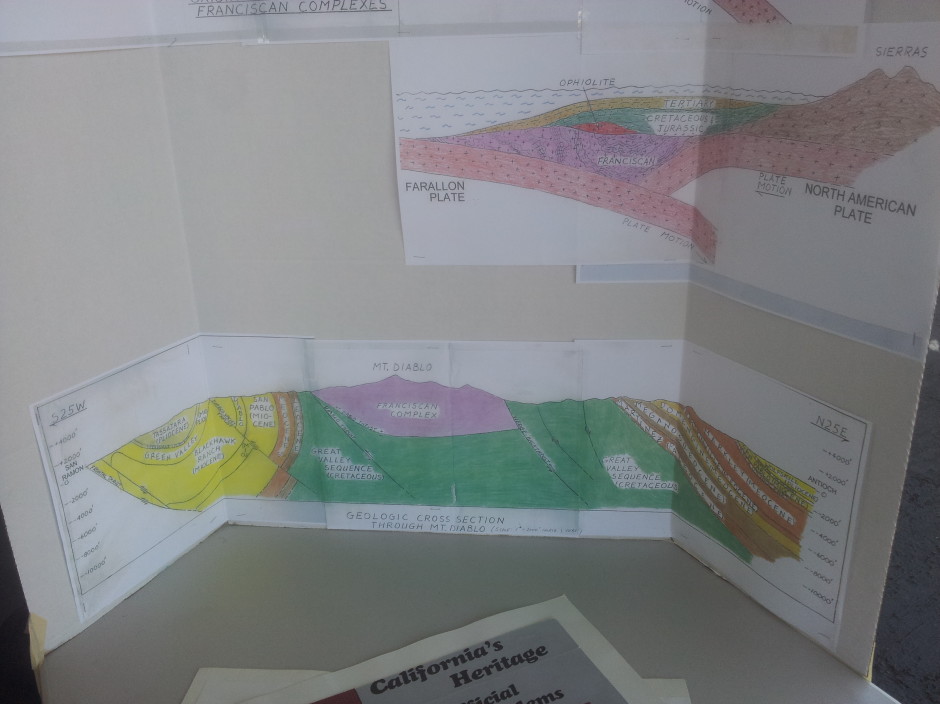
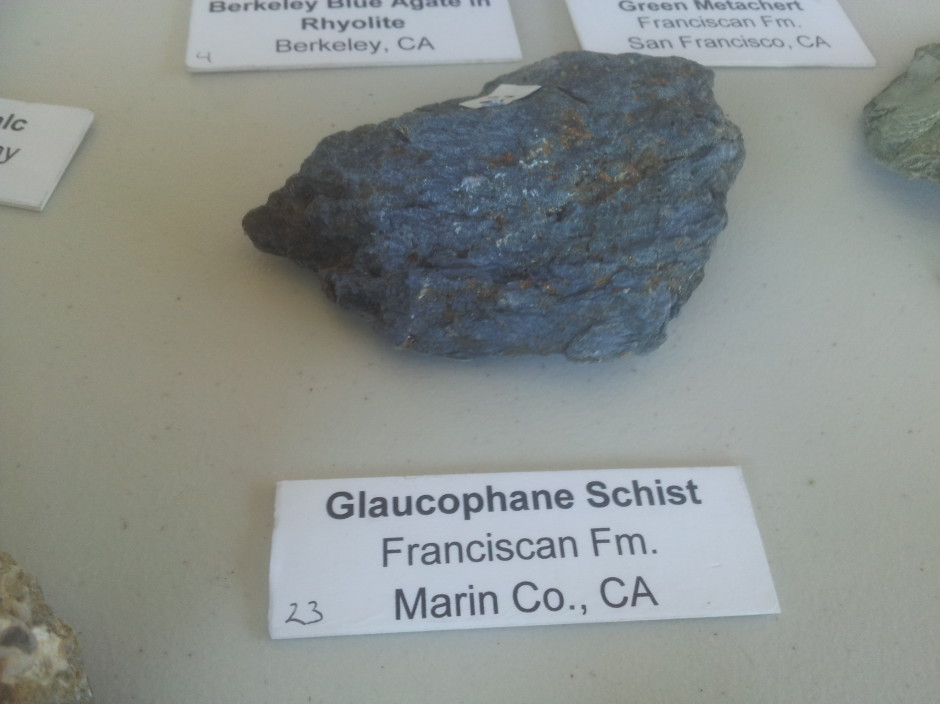
Alfredo Petrov has long been one of my favorite mineral dealers for the scientific focus of his merchandise. In addition to specimens of many truly weird minerals, he often has specimens of odd reagents or elements. He had several vials and containers of selenium, calcium, lithium, and samarium. I encourage the sale of element samples at mineral shows. Element collecting was quite popular a few years back but seems to have tapered slightly at least in the US. As for minerals, hw of course had a lot of oddball specimens..in fact too much to mention. Some of my favorites were his tiny sapphires panned from Japanese alluvial gravels, analcime and natrolite with celadonite from East Greenland- far away from the famous mineral producing regions on the frigid island. I thought one of the nicer high end pieces he had was this English torbernite. It is priced very competitively considering the quality of the specimen, high pedigree A.E. Foote label, and overall rarity of the material.
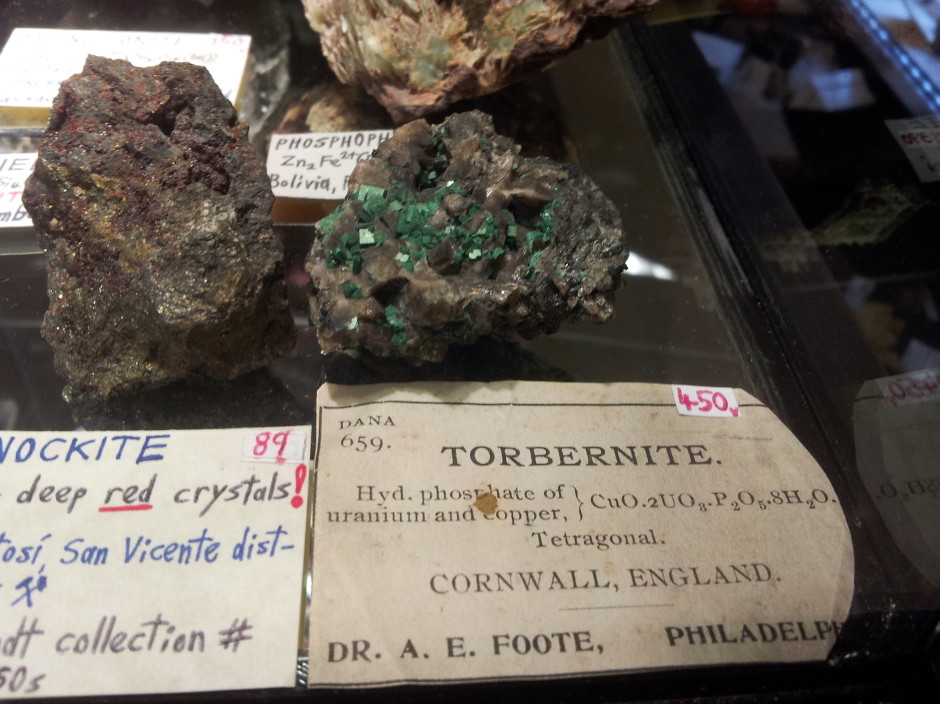
I have been a customer of Mineralogical Research Corporation (Minresco) in the past so it was great visiting their booth and looking through some of their flats in person. They had lots of fine quality, well known material from worldwide locations displayed in the front of the booth and rarer specimens behind. As for the material out front, I thought their specimens of the new azurite find from Lavrion, Greece were some of the better I have seen. I did however spend most of my time looking at the rare material in the back flats which was perhaps the most varied material in the entire show. I will refrain from mentioning my favorites because there were just simply too many. I did think this vial of szabelyite from Bou Azzer Morocco was pretty cool considering it was probably collected and studied far before the mine produced the specimens it is currently famous for. It may likely be one of the earliest collected mineral specimens from Morocco in circulation. That may not be saying much though considering that the vast majority of Moroccan pieces are no more than 20 years old. I still thought it was very interesting to see.
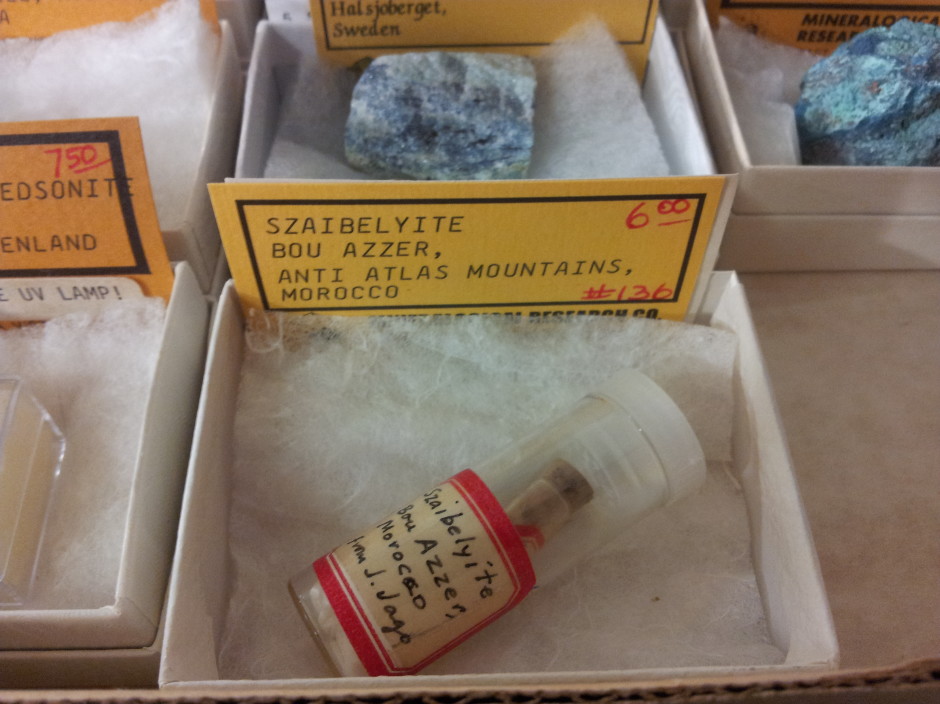
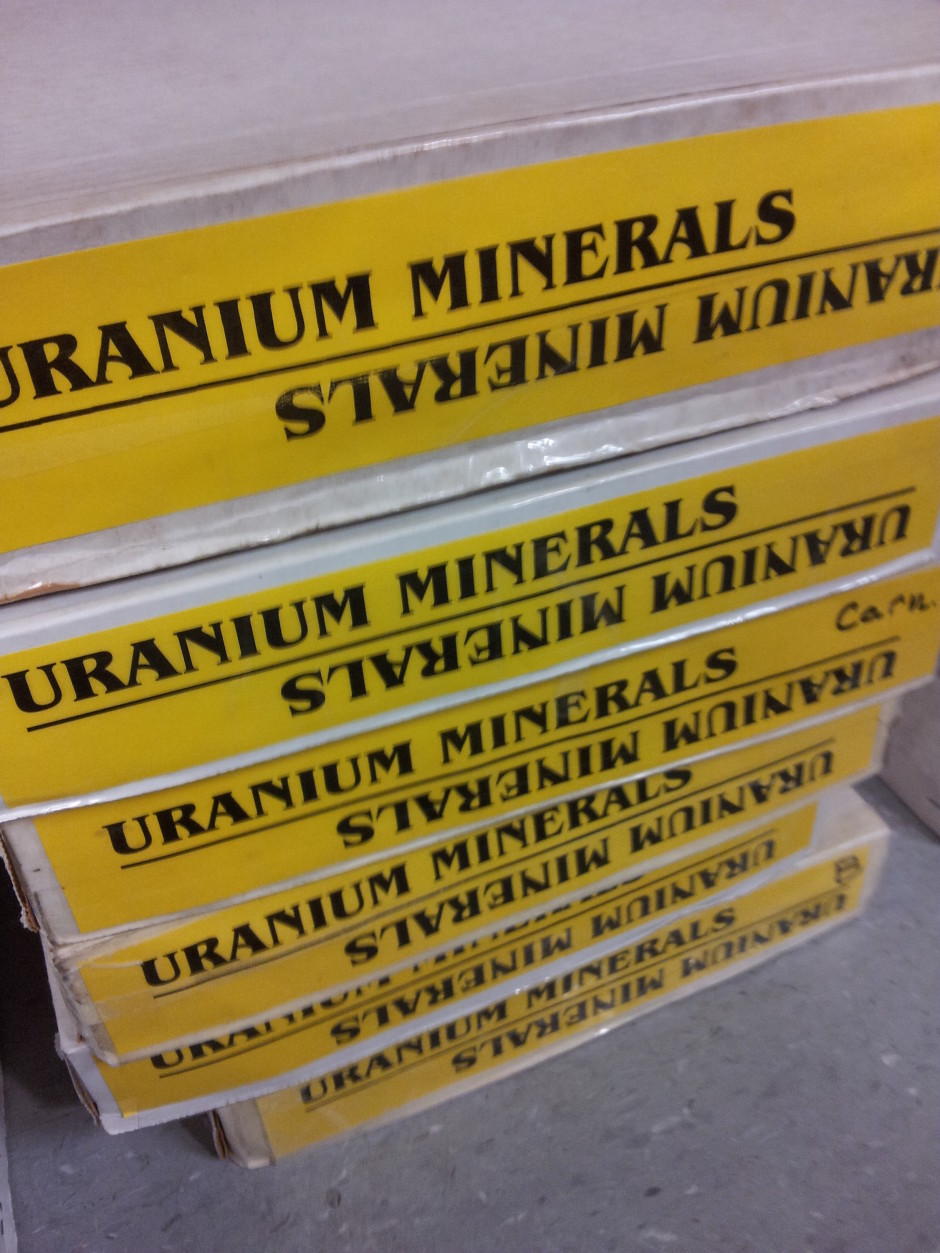
The 2014 Castro Valley Show was great fun and it was definitely geared to a wider audience than I feel most smaller local mineral shows tend to target. Not only was there great diversity of material available, but amazing deals to be had. Not only is this a great show for everyone interested in minerals as a hobby, but would be rewarding for dealers looking to obtain inexpensive, high quality material for their inventory. As far as improvements, my only big criticisms were that I wish the displays had better labeling and there was more emphasis on local field collecting in them. I cannot say the show had any other drawbacks for me considering its nature and size. I thought it was awesome!!! This is a great event that I hope continues to be held for many years in the future!
Below is a specimen purchased at the Show which is available from Earth Surgery – Contact at JZolanSci@gmail.com to inquire.
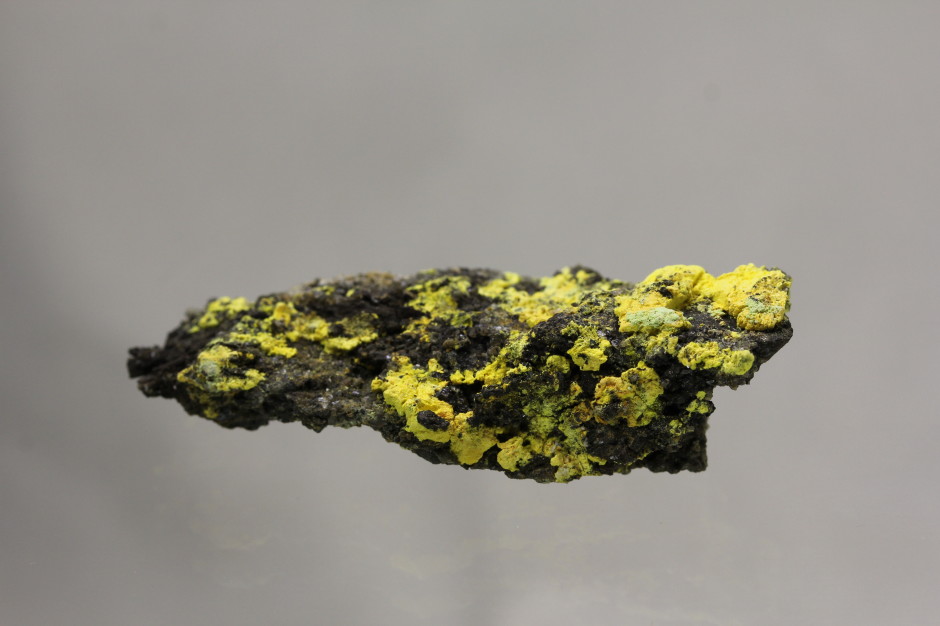
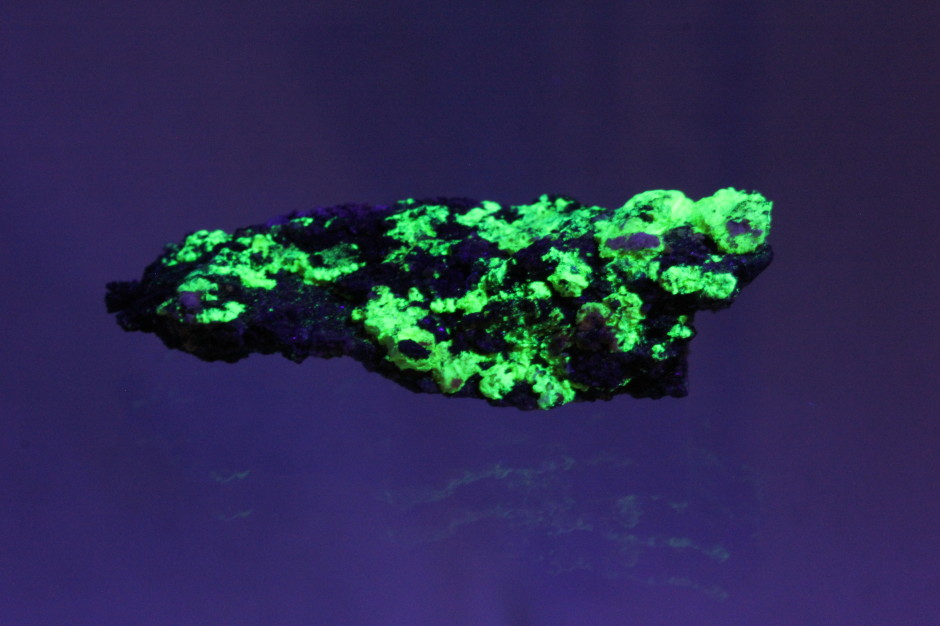
Uranopilite- $100
(UO2)6(SO4)O2(OH)6·14H2O
Happy Jack Mine, White Canyon Dist., San Juan Co., UT
Ex. Dr. Eugene B. Gross
6.7 x 2.4cm 21.81g
email JZolanSci@gmail.com to order
The rare uranium secondary uranopilite is rarely available in specimens as rich as this one where it is present as bright highlighter-yellow powdery masses in a dark sedimentary matrix. The uranopilite masses may be poorly defined crystals. Typical of most uranyl minerals, the specimen is vividly fluorescent in all UV wavelengths and slightly radioactive. The identity of this specimen is highly credible- this specimen resided in the personal collection of Dr. Eugene B. Gross; a geochemist who prospected the uranium deposits of Utah for the Atomic Energy Commission.
Uranopilite has a very odd structure in that it is a polymer composed of metal oxo-clusters linked by sulfate “couplings.” This phenomenon of uranyl-clustering is observed in a select few uranyl species and have some structural characteristics of formal polyoxometallates, which of only one occurs in nature. If you wish to inform yourself more on the cluster chemistry of they uranyl cation, especially in minerals, I recommend this paper: http://minmag.geoscienceworld.org/content/75/1/1/F3.expansion.html
To search for minerals for sale that were mined in California, check out this search for minerals of California on eBay

